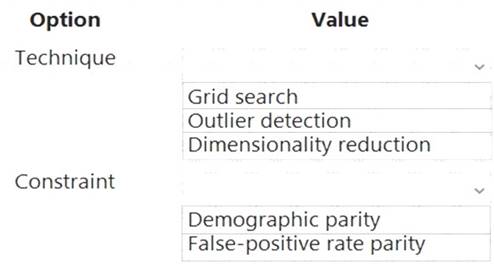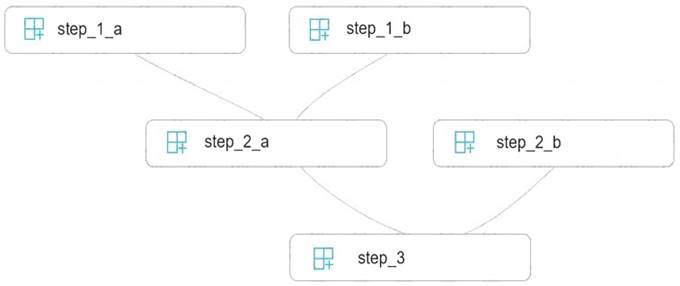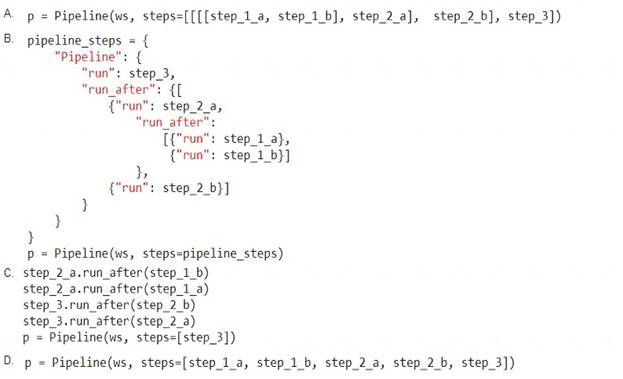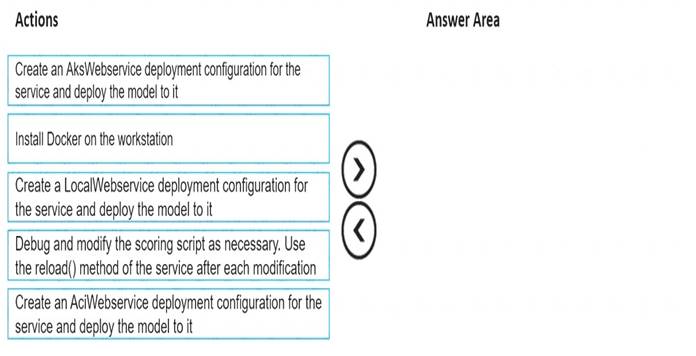- (Exam Topic 3)
A biomedical research company plans to enroll people in an experimental medical treatment trial.
You create and train a binary classification model to support selection and admission of patients to the trial. The model includes the following features: Age, Gender, and Ethnicity.
The model returns different performance metrics for people from different ethnic groups.
You need to use Fairlearn to mitigate and minimize disparities for each category in the Ethnicity feature. Which technique and constraint should you use? To answer, select the appropriate options in the answer area. NOTE: Each correct selection is worth one point.
Solution:
Graphical user interface, text, application, chat or text message Description automatically generated
Box 1: Grid Search
Fairlearn open-source package provides postprocessing and reduction unfairness mitigation algorithms: ExponentiatedGradient, GridSearch, and ThresholdOptimizer.
Note: The Fairlearn open-source package provides postprocessing and reduction unfairness mitigation algorithms types: Reduction: These algorithms take a standard black-box machine learning estimator (e.g., a LightGBM model) and generate a set of retrained models using a sequence of re-weighted training datasets.
Reduction: These algorithms take a standard black-box machine learning estimator (e.g., a LightGBM model) and generate a set of retrained models using a sequence of re-weighted training datasets. Post-processing: These algorithms take an existing classifier and the sensitive feature as input.
Post-processing: These algorithms take an existing classifier and the sensitive feature as input.
Box 2: Demographic parity
The Fairlearn open-source package supports the following types of parity constraints: Demographic parity, Equalized odds, Equal opportunity, and Bounded group loss.
Reference:
https://docs.microsoft.com/en-us/azure/machine-learning/concept-fairness-ml
Does this meet the goal?
Correct Answer:
A
- (Exam Topic 3)
You write five Python scripts that must be processed in the order specified in Exhibit A – which allows the same modules to run in parallel, but will wait for modules with dependencies.
You must create an Azure Machine Learning pipeline using the Python SDK, because you want to script to create the pipeline to be tracked in your version control system. You have created five PythonScriptSteps and have named the variables to match the module names.
You need to create the pipeline shown. Assume all relevant imports have been done. Which Python code segment should you use?
Correct Answer:
A
The steps parameter is an array of steps. To build pipelines that have multiple steps, place the steps in order in this array.
Reference:
https://docs.microsoft.com/en-us/azure/machine-learning/how-to-use-parallel-run-step
- (Exam Topic 3)
You train and register a model by using the Azure Machine Learning SDK on a local workstation. Python 3.6 and Visual Studio Code are installed on the workstation.
When you try to deploy the model into production as an Azure Kubernetes Service (AKS)-based web service, you experience an error in the scoring script that causes deployment to fail.
You need to debug the service on the local workstation before deploying the service to production.
Which four actions should you perform in sequence? To answer, move the appropriate actions from the list of actions to the answer area and arrange them in the correct order.
Solution:
Graphical user interface, text, application, email Description automatically generated
Step 1: Install Docker on the workstation
Prerequisites include having a working Docker installation on your local system. Build or download the dockerfile to the compute node.
Step 2: Create an AksWebservice deployment configuration and deploy the model to it
To deploy a model to Azure Kubernetes Service, create a deployment configuration that describes the compute resources needed.
# If deploying to a cluster configured for dev/test, ensure that it was created with enough
# cores and memory to handle this deployment configuration. Note that memory is also used by
# things such as dependencies and AML components.
deployment_config = AksWebservice.deploy_configuration(cpu_cores = 1, memory_gb = 1)
service = Model.deploy(ws, "myservice", [model], inference_config, deployment_config, aks_target) service.wait_for_deployment(show_output = True)
print(service.state) print(service.get_logs())
Step 3: Create a LocalWebservice deployment configuration for the service and deploy the model to it
To deploy locally, modify your code to use LocalWebservice.deploy_configuration() to create a deployment configuration. Then use Model.deploy() to deploy the service.
Step 4: Debug and modify the scoring script as necessary. Use the reload() method of the service after each modification.
During local testing, you may need to update the score.py file to add logging or attempt to resolve any problems that you've discovered. To reload changes to the score.py file, use reload(). For example, the following code reloads the script for the service, and then sends data to it.
Reference:
https://docs.microsoft.com/en-us/azure/machine-learning/how-to-deploy-azure-kubernetes-service https://docs.microsoft.com/en-us/azure/machine-learning/how-to-troubleshoot-deployment-local
Does this meet the goal?
Correct Answer:
A
- (Exam Topic 3)
For each of the following statements, select Yes if the statement is true. Otherwise, select No. NOTE: Each correct selection is worth one point.
Solution:
Does this meet the goal?
Correct Answer:
A
- (Exam Topic 3)
You use the Two-Class Neural Network module in Azure Machine Learning Studio to build a binary classification model. You use the Tune Model Hyperparameters module to tune accuracy for the model.
You need to select the hyperparameters that should be tuned using the Tune Model Hyperparameters module. Which two hyperparameters should you use? Each correct answer presents part of the solution.
NOTE: Each correct selection is worth one point.
Correct Answer:
DE
D: For Number of learning iterations, specify the maximum number of times the algorithm should process the training cases.
E: For Hidden layer specification, select the type of network architecture to create.
Between the input and output layers you can insert multiple hidden layers. Most predictive tasks can be accomplished easily with only one or a few hidden layers.
References:
https://docs.microsoft.com/en-us/azure/machine-learning/studio-module-reference/two-class-neural-network

